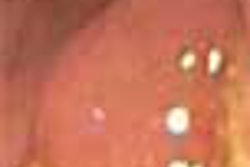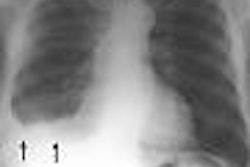The 2004 International Symposium on Multidetector-Row CT in San Francisco covered the modality from its most technical aspects to the broader social issue of CT screening. The four-day event was sponsored by the Stanford University School of Medicine in Stanford, CA. The course director was Dr. Gary Glazer, chairman of the department of radiology at Stanford. Dr. Geoffrey Rubin, the chief of cardiovascular imaging at the university, served as program director.
CT and MRI
Several talks focused on the compatibility of the two modalities. Dr. Jay Cinnamon, director of neuroradiology and associate professor of radiology at the Emory University School of Medicine in Atlanta, discussed how both MR and CT can reduce the devastation of acute stroke by separating the patients likely to benefit from antiplatelet or thrombolytic therapy from those in whom intervention would only heighten the risk of injury.
Dr. Georges El-Khoury, director of the musculoskeletal radiology section and professor of radiology and orthopedics at the University of Iowa Hospitals and Clinics in Iowa City, also advocated using MDCT and MRI for assessing thoracolumbar injuries. While MDCT is best suited for bone and hardware, MRI is ideal for soft tissues in the spine like neural elements, disk ligaments, marrow, as well as a few collections like cysts and abscesses, he explained.
Refining CT imaging
Two presentations went back to the basics. Rubin covered the practical issues of selecting detector width, pitch, and rotation speed. Scan times and distances, detector rows, and rotation times all have a direct impact on image quality.
Meanwhile, Dr. Sanjay Saini, professor of radiology at Harvard Medical School and director of CT services at Massachusetts General Hospital in Boston, offered ideas on how tinkering with mA and kVp can reduce radiation, while still creating high-quality diagnostic images.
In another talk, Cinnamon, who also is affiliated with Quantum Radiology Northwest in Marietta, GA, made a case for MDCT for diagnosing and following patients with cervical spine trauma. Cinnamon urged his audience to break free of traditional CT protocols and think of the slices as volumetric, isotropic data.
Dr. Joan Lacomis, associate professor of radiology at the University of Pittsburgh Medical Center, described the evolution of CT-guided radiofrequency catheter ablation, which is being performed with increasing frequency to treat common cardiac dysrhythmia. Its success is highly dependent on detailed MDCT images that enable the electrophysiologist to understand the complex anatomy of the distal pulmonary veins and the left atrium, Lacomis said.
CT practice management, screening
Saini also discussed ways to optimize CT imaging through large-scale efficiency plans. The goal of a successful CT department should be to acquire more scans through proper workflow management, he said, and automation and standardization are important to achieve that goal.
Across the pond, CT utilization has increased rapidly since 2000, and the U.K. National Health Service is making a serious push to bolster equipment supplies and keep up with demand, said Dr. Adrian Dixon, professor of radiology at the University of Cambridge and honorary consultant radiologist at Addenbrooke's Hospital in Cambridge.
In a panel discussion, various CT experts reviewed the current literature on CT screening with the goal of determining whether CT screening is advisable. While CT screening does have its pluses, the debate over its ultimate value won't be resolved by any conclusive studies in the near future, they added. The panelists included Dr. Fergus Coakley from the University of California, San Francisco and Dr. David Yankelevitz of Cornell University in Ithaca, NY.
Two Dutch radiologists put in their two cents worth with a debate on the risks and benefits of CT screening. Dr. Aart van der Molen from Leiden University Medical Center, the Netherlands, advocated using linear nonthreshold (LNT) dose relation to approximate individual risk. Dr. Mathias Prokop from the University Medical Center in Utrecht, the Netherlands, countered that radiation dose is less important than the results of other risk models, such as radiation hormesis, and the greater problem of limited healthcare resources.
Finally, some vendors chose the Symposium on Multidetector-Row CT to introduce new products, including a new 64-slice CT scanner by Toshiba America Medical Systems of Tustin, CA. Siemens Medical Solutions of Malvern, PA, unveiled a revamped version of its 64-slice CT platform, optimized for cardiac, thoracic, and vascular imaging.
By Shalmali Pal
AuntMinnie.com staff writer
September 8, 2004
Copyright © 2004 AuntMinnie.com




















